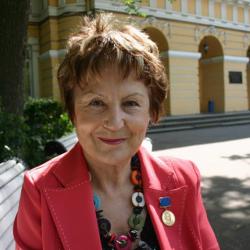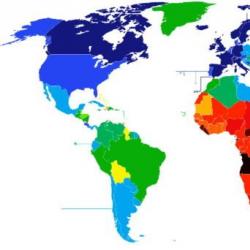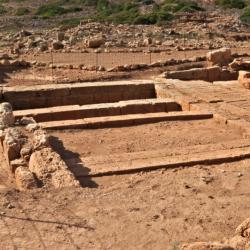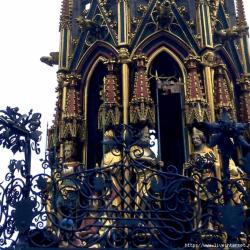Fountain matrimonial carousel. Fountain wedding carousel in Nuremberg. Fountain "Night Watchman"

It was supposed to be placed on one of the churches, but the city did not have money and it was placed on a fountain. With a height of 19 meters, it rises above the octagonal basin of the fountain.
The gold-covered fountain is decorated with 40 figures standing one above the other on four levels.

The reason this fountain is famous is the ring set into a beautiful lattice.
According to legend, one young man, who was an apprentice to a locksmith and wanted to marry his master’s daughter, inserted this ring in one night, which made an indelible impression on his beloved and her father.
Since then, city residents and tourists have touched this ring and made wishes.
It was not possible to photograph the ring, only because it is not visible behind bars, and in order to touch it you also have to wait for your turn.

The Fountain of Virtues was built in 1589, commissioned by the city council of the Free City of the Empire, which were intended to demonstrate their position in the world.

Six allegories of three theological and three cardinal virtues with their attributes are placed on a round platform: Faith with a cross and cup, Love with two children, Hope with an anchor, courage with a lion, Temperance with a jug and Patience with a lamb.
Above the figures, cherubs bear two coats of arms of the city of Nuremberg. The seventh force, Justice, stands at the top of the pillar with a blindfold, a sword and a tap as a symbol of vigilance.

The sculptural group by Jürgen Weber was created based on the late 15th century satirical book “Ship of Fools” by Sebastian Brant.
In the book, Brant described a whole string of fools, carriers of stupidity and vices, who were about to go on a ship to the Kingdom of Stupidity.

When with such difficulty, stubbornly
I am this poetic ship
Created with my own hands,
Filled with fools
That had no purpose, of course.
Bath them all in the sea bath:
Each one scraped his own body.
However, here is another matter:
Some idiots in my book
(They were pretty drunk)
They added their own rhymes.
But among other fools
They, without realizing it,
Languishing under the hot sun,
Already on the ship ourselves
Everyone was lying under sails:
I tell them in advance, on land,
Donkey ears!

The Marriage Carousel fountain in the center of Nuremberg is considered a significant piece of modern art from the second half of the 20th century and is the largest sculpture fountain erected in the 20th century.
When laying the metro line, it was necessary to disguise the exit of the ventilation shaft right in the middle of the square, so it was decided to build a fountain.
A creative competition was announced for the best project; it was won by the sculptor Professor Jürgen Weber, who presented a composition based on the poem “Das bittersüße eh"lich" Leben" (“Bittersweet Family Life”) by the most famous Nuremberg poet Hans Sachs.
Sachs reflected in his work the happy and bitter sides of his 22 years of family experience.

The sculptor embodied the dark and light moments of marriage in the form of a carousel, which is why the fountain is called the “Marriage Carousel”
Different episodes of the family journey are reflected in six sculptural groups, and not a single element of the composition is accidental, everything is full of deep symbols and hints.

Love is depicted by a young couple on a swan bed.
Lovers reach out to each other in anticipation of a kiss, just like two swans stretch out their beaks towards each other.
Swans in Greek and Germanic mythology are birds of love. And their feathers are depicted as tongues of flame of passion.

The gondola of flames depicts a mature couple in an eternal quarrel, bound by one chain.
He is like the devil with his anger, she is like a witch who does not want to obey.

Half-decayed figures, these are human souls, are waging their eternal war beyond the earthly threshold, who will win.....

Here it came to fruitless attempts to end the quarrel by strangling the partner.
The family idyll is presented on a pedestal in the form of a pelican - a symbol of maternal love. But the father somehow looks to the side indifferently.
The pelican tears out its heart with its beak - an allusion to the legend of the mother who fed her hungry children with her heart.

An overweight wife is eating a piece of cake, and it looks like she has taken the last piece from her husband.
The husband, emaciated and stripped naked, prays to heaven.
The original fountain called the Marriage Carousel is located in the Bavarian city of Nuremberg, Germany. An unusual fountain, also called the Marriage Carousel, is located in the central part of the city, on Ludwigsplatz Square.

The marriage carousel has been spinning in the center of Nuremberg since 1984. The author of the monumental fountain based on the poem “Bittersweet Family Life” by the German poet and composer Hans Sachs (1494-1576) was the sculptor Jurgen Werber. The history of the creation of this strange masterpiece of modern art is as unique as the fountain itself.

When the metro line was laid in Nürnberg, a ventilation shaft was built right in the center of Ludwigsplatz. Since it openly disfigured the historical appearance of the city, they decided to cover up the resulting hole with something, so the city authorities announced a competition for the best camouflage project. As a result, the winner was the design of the Marriage Carousel fountain by Jürgen Werber.

The fountain consists of six scenes, the participants of which are a married couple going through all the vicissitudes of marriage. First meeting, passion and declarations of love, long family life, old age together and death. , that on the bas-relief of the Marriage Carousel fountain is embossed not only the verse that did not inspire its creation, but also the date 07/01/1977 - the day of the adoption of a new divorce law in Germany, which made the already unpleasant procedure even more complicated.

The Marriage Carousel Fountain is an interesting and rather controversial example of modern art. It should be noted that his appearance in the central square of Nrnberg shocked the townspeople and caused outrage among many. The excessive frankness and indiscretion of the unusual sculptural composition really evokes very mixed emotions.

The artistic value of the original Nuremberg fountain, the Marriage Carousel, has been questioned more than once. But over time, the townspeople got used to the unusual monument and the passions around it slowly subsided. Now the Marriage Carousel is the largest sculptural fountain of the 20th century and one of the popular attractions of the city of Nuremberg.
The fountain sculptures of Nuremberg amazed and surprised me very much. I have never seen anything like this anywhere. These stunning sculptures, made in an amazingly grotesque and at the same time amazingly realistic way, sincerely delighted me. I really hope that they will bring you sincere pleasure!
Fountain "Matrimonial Carousel"
(as well as the “Matrimonial Fountain”), in fact, the Hans-Sachs-Brunnen (Hans Sachs Fountain) is one of the largest architectural fountains in Nuremberg, located in close proximity to the famous White Tower. It is considered the largest fountain of figures in Europe of the 20th Century.
The fountain was created in Nuremberg from 1977 to 1981 by sculptor Jürgen Weber at the request of the city and was commissioned in 1984. The reason for the construction of this remarkable fountain was the prosaic underground ventilation shaft of the subway, which was supposed to be built at the same time (and is currently located in the center of the fountain). The then Nuremberg construction supervisor, Otto Peter Görl, came up with this wonderful idea to hide the holes for the exit of the shaft - to cover it with a fountain. The Brunswick sculptor Jürgen Weber coped with the mission remarkably well and the fountain was put into operation.
As a work of art, the fountain, due to the expressive and figurative (in my opinion, even grotesque) figures that are considered part of the population, was labeled by the press as sharply vulgar, and also due to significant budget overruns, this work of art was initially very controversial. The artist was also accused of "pseudo-baroque sexualism" and these reproaches and accusations were renewed in connection with his new work "Ship of Fools", also executed by Weber in 1988. Today the fountains are one of the most important tourist attractions of modern art in Nuremberg. Inspiration for The fountain was inspired by the poem “Bittersweet Married Life” written by the poet Hans Sachs for his wife. The fountain clearly shows six different scenes: consisting of the ups and downs of married life - from the first passionate love, through family discord until Death itself.
The fountain consists of painted and partially fire-gilded bronze figures. The author of the text on the pedestal is also Hans Sachs.
The body of the pool is made of white and gray marble in the Baroque style, and parts of the decorations are made of colored marble. On the western side is "Rosenstock". It consists of green and pink veined Portuguese marble. Weber made green leaves from green marble and rose petals from pink marble.
Bittersweet
married life
then downs, then ups
and the beginning is passionate love
then sunsets, then sunrises...
In Nuremberg, on Ludwigplatz there is a very unusual and original fountain. It's called "The Marriage Carousel". It is also called the “Marriage Carousel”. If you are lucky enough to visit Nuremberg, be sure to go to this fountain, you won’t regret it. The “Married Carousel” fountain was created based on the work of the German poet and composer Hans Sachs. During the construction of the metro in the city, a ventilation shaft had to be built right on the square. However, she did not paint the city and local authorities announced a competition for the best camouflage of this hole. The competition was won by sculptor Jürgen Werber.
The idea for the composition of the fountain came to his mind after reading a poem by the most famous Nuremberg poet of the Middle Ages, G. Sachs, “Bittersweet Married Life.”
The composition of the fountain is designed in such a way that each side of the fountain represents a scene from the life of the spouses, the bright and dark moments of marriage. Six sculptural compositions are arranged in a circle on stylized trailers in the form of different animals and reflect various episodes of married life. Each composition is a hint and a hidden meaning, which not everyone can unravel, but something is still clear.

The wife is a fairly well-fed woman, but she devours her husband’s portion; her own plate stands untouched. But my husband doesn’t care, he’s happy with life. What does this mean? Most likely about her carelessness in family life. By the way, this entire composition is located on a wolverine devouring a fish. The exact translation of wolverine in German is glutton. Then think for yourself.

It seems like a prosperous family at the dawn of its happiness. A mother feeds her children, a boy and a girl, with her husband nearby. But my husband looks in a completely different direction. There is something he doesn’t like in this life. Maybe a wife? This whole idyll is located on a pelican - a symbol of maternal love.

On the paw of the dragon from the underworld you can see an inscription with the numbers 07/01/1977. This is the date of the adoption of the new divorce law in Germany.

The perfect married couple on swans. Everything is fine with them, they are about to kiss.

Aged couple. Life together is so boring that it’s impossible, but there’s nowhere to go. So they swear like devils, chained forever with one chain.

A woman reaches out to an ear of corn on which G. Sachs himself is sitting. In the background you can see a column in the form of a funeral wreath, symbolizing that in the end everyone, both friendly and unfriendly families, will end up there at the top. Sooner or later.
The “Matrimonial Carousel” fountain in Nuremberg initially caused heated debate about whether the city needed such a philosophical composition and they even wanted to ban it, but common sense in art won. Nowadays it is the most visited attraction in Nuremberg.
These are the verses of Sax that prompted the sculptor to create such an unusual fountain:
“Married life is the epitome of joy,
The “bouquet” will add a sour taste.
How beautiful you are, family joys,
They are just as difficult, there is no doubt.”
Quatrains from the poem are carved on some fragments of the fountain.
- < Назад
When the “Marriage Carousel” fountain appeared on the square near the White Tower, it immediately aroused the indignation of the pious local public, who considered the sculptures the height of obscenity. This happened in 1984. And what do you think, after thirty years the “fountain passions” have faded away? Nothing like this! Heated debates and discussions occur here today. The topic is eternal.
It all started with the White Tower, which appeared in Nuremberg in 1250, becoming part of the fortress wall surrounding the city. The white color of the tower turned out to be not very practical, the tower had to be whitewashed often, but the townspeople found a way out - they began to send particularly grumpy wives here for forced labor.
Several centuries have passed...
After World War II, during restoration work, the plaster from the tower was removed.
Since then, she is no longer white, and wives have not been sent to her for re-education for a long time. One name left.
In 1972, the White Tower began to serve as the entrance to the metro. It was the construction of the metro that served as a prerequisite for the appearance of a fountain on the square, which stirred up serious passions, and a curiosity related to the past occurred in the history of Nuremberg. I think you'll appreciate it.

During the construction of the Nuremberg metro, a ventilation shaft was formed in front of the White Tower, disfiguring the appearance of the square. They began to come up with ways to camouflage the mine and announced a creative competition. As a result, the winner was the sculptor Jurgen Weber, who proposed an original sculptural composition he created based on the poem “Bittersweet Family Life” by the famous poet Hans Sachs, who lived in Nuremberg at the very time when the White Tower was still being whitewashed. In the poem, the poet describes his personal 22-year experience of family life, its bitter-sweet “taste.” The sculptor presented all stages of marriage in the form of a cycle reflecting the course of life.

This is what the square looked like until the end of the seventies. I took a photograph from a photograph taken in 1920 at the exhibition "Nuremberg in Photographs 1904 - 1944". If there had not been a metro station here, perhaps there would not have been a fountain. The White Tower is on the left, it is not visible in the photo, but we started talking not about it, but about our passions.

So.
The six bronze sculptural groups of the Marriage Carousel fountain are full of hidden symbols and hints; irony and sadness are intertwined in them. And above all this splendor, the poet Hans Sachs himself rises on a marble corncob. He laughs and dances, turning away from his family vicissitudes.

A young temptress and a musician-fan emerging from a sea shell, and next to them a galloping goat as a symbol of life and fertility. At the bottom is the inscription: "Till death do you part."

Lust
Young spouses bask on a beautiful swan bed - a symbol of love and fidelity.
Their smooth, healthy bodies are about to merge in ecstasy.

Idyll
A caring mother feeds her children apples on a bed in the shape of a pelican - a symbol of motherhood. A pelican tearing a heart out of its chest, as an allusion to the legend of a mother who fed hungry children with her heart.

Pay attention to the sideways gaze of the husband, dreaming of heavenly pies :))

Routine
The chicks flew away from the nest. They were left alone - an exhausted, helpless, humiliated husband, but continuing to dream, and a well-fed tyrant wife, devouring a piece of fatty cake on both cheeks.

Apogee
The ugliness has reached its peak: the husband and wife are tired of each other, of mutual reproaches and quarrels, but they cannot change anything, they are forever shackled by the chains of marriage.

The final
A huge dragon raises a couple of skeletons from the depths of Hell. The couple have already completed their journey together, but cannot find peace in the next world. Masochism...such is masochism.

It is noteworthy that the date 07/01/1977 is stamped on one of the dragon’s paws. On this day, a new divorce law was adopted in Germany.


The pink Portuguese marble heart is engraved with the lines of a Hans Sachs poem and the years in which the fountain was created.

And at the end of the story - one of the most beautiful translations of the poem “Bittersweet Family Life”:
Glory to the Most High and Almighty
I sing glory to our Lord
Glory to him who gives to all things
He sent me my wife
Married life is the epitome of sweetness
The bouquet will add a sour taste
How wonderful are you family joys
Just as difficult, there is no doubt
My angel, exemplary life partner
So good, and sweet, and kind
There is a mistress and a faithful wife in the house
Brings a lot of goodness to my house
True, often a thunderstorm gathers
Thunder and lightning, tears and screams
My wife swears very loudly
He scolds often, but I'm already used to it
Sometimes I don’t want to rush home
The angry woman there is driving you crazy
But if misfortune happens to me
My wife will become my support
In life, my reliable shield and help
There is so much life in her, so much fire
It will warm you up in winter, but - for God's sake!
Let her nag me less
Cooks deliciously, washes cleanly
Sews, embroiders, sings like a nightingale
Argues, screams, forgives nothing
My joy, my punishment
My confessor and tempter
Where she is is both a palace and a prison
Blessed be the Almighty Savior
She has been with me for twenty-two years.







